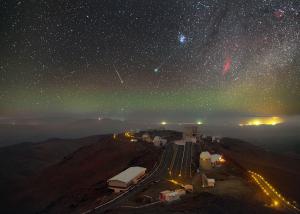Blog
Take the Shot
11 February 2015
 Petr Horálek
Petr HorálekThis image might look like something created in Photoshop, but it is very real. It was produced from a series of long exposures by Petr Horálek, and it captures a range of astronomical objects in a single image.
In the center is Comet Lovejoy, which you might notice has a bit of a greenish tint. Just to the left of Lovejoy is a meteor, far too small to reach the Earth, but bright enough to announce its arrival in our atmosphere. Above and to the right of Lovejoy is the open cluster known as the Pleiades, which is one of the most recognizable star clusters in the night sky. The red arc on the right is the California Nebula, which is an emission nebula. Its red coloring comes from atomic hydrogen that’s excited by ultraviolet light. Throughout the upper right region you can see the diffuse light of the Milky Way, with darker dusty regions within it. The greenish glow near the horizon is an effect known as airglow. It isn’t an aurora, but a very faint glow due to excited particles in the upper atmosphere. Airglow is fairly uniform throughout the sky, but it is most noticed near the horizon, since in that direction we look through the most atmosphere.
It’s a striking image brings home the fact that the night sky is filled with light and color. With the limited light sensitivity of our eyes, and our often light-polluted vantage points, it’s easy to forget that fact.